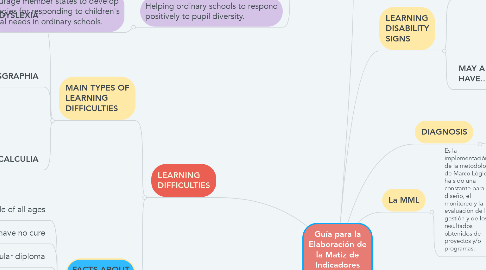
1. SUPPORT
1.1. Case manager or services coordinator may be helpful.
1.2. Avoid simplistic, negative labels and help him or her look at itself in a comprehensive and positive manner.
1.3. Focus on the present problems and attend to other associated concerns children with learning disabilities respond well to a sensitive and appropriate evaluation and treatment
1.4. Helping ordinary schools to respond positively to pupil diversity.
1.4.1. Encourage member states to develop strategies for responding to children's special needs in ordinary schools.
2. LEARNING DIFFICULTIES
2.1. MAIN TYPES OF LEARNING DIFFICULTIES
2.1.1. DYSLEXIA
2.1.1.1. Trouble making the connection between letters and sounds and with spelling and recognizing words.
2.1.2. DYSGRAPHIA
2.1.2.1. Trouble writing or has very poor handwriting and does not outgrow.
2.1.2.1.1. May cause the person to be tense and twist awkwardly when holds in a pen or pencil.
2.1.2.2. OTHER SIGNS
2.1.2.2.1. Strong dislike of writing and/or drawing, losing energy or interest as soon as they start writing
2.1.3. DYSCALCULIA
2.1.3.1. Disability include problems understanding basic arithmetic concepts.
2.1.3.2. OTHER SIGNS
2.1.3.2.1. Difficulty with math related word problems, making change in cash transactions, logical sequences, messiness in putting math problems on paper
2.2. FACTS ABOUT LEARNING DIFFICULTIES
2.2.1. LD affect people of all ages
2.2.2. LD have no cure
2.2.3. Only 67% of students with LD graduate from high school with a regular diploma
2.2.4. 20% of students with LD drop out of high school
2.2.5. Only 10% of students with LD are enrolled in a 4 year college within 2 years of leaving school
2.2.6. Among working-age adults with LD only 55% are employed
2.2.7. People with LD are more likely to report fair to poor physical, general and mental health
3. When student need some additional support in their schooling process, the curricular adjustments are necessary for the educational strategy to achieve the purposes of teacher.
3.1. Must take into account the interests, motivations, abilities and needs of the students, so that they have a significant impact on their learning.
3.2. Certain priorities must be established based on the main needs of the student through psychopedagogical evaluation
3.2.1. 10 CRITERIAS
3.2.1.1. Compensation, Autonomy / functionality, Acquisition probability, Sociability, Significance, Variability, Expansion of areas, etc.
4. 2000. La Integración Educativa En El Aula Regular. 3rd ed. [ebook] Mexico: SEP, pp.1-199. Available at: <https://anahuac.brightspace.com/d2l/le/lessons/42425/topics/436817
5. REFERENCES
5.1. Learning Infographics. 2020. 10 Important Facts About Learning Disabilities In Children Infographic - E-Learning Infographics. [online] Available at: <https://elearninginfographics.com/10-important-facts-about-learning-disabilities-in-children-infographic/>
5.2. Yanome, Y., 2020. Learning Problems Detection.
5.3. 1993. Special Needs In The Classroom. [ebook] France: UNESCO, pp.1-195. Available at: <https://anahuac.brightspace.com/d2l/le/lessons/42425/topics/436821>
6. DIAGNOSIS
6.1. Special tests are required to make a diagnosis.
7. La MML
7.1. Es la implementación de la metodología de Marco Lógico, ha sido una constante para el diseño, el monitoreo y la evaluación de la gestión y de los resultados obtenidos de proyectos y/o programas.
7.1.1. A full evaluation for a learning disability includes:
7.1.1.1. Medical exam, child's developmental, social and school performance review, family history, academic and psychological testing
7.1.2. Teachers, parents, pediatricians and schools specialists help formulate it.
8. LEARNING DISABILITY SIGNS
8.1. COMMON SIGNS
8.1.1. Problems reading and/or writing, math
8.1.2. Poor memory, clumsiness, trouble telling time and staying organized.
8.1.3. Trouble paying attention and following directions
8.2. MAY ALSO HAVE...
8.2.1. Acting without really thinking about possible outcomes, acting out in situations
8.2.2. Difficulty staying focused and listening
8.2.3. Problems with school performance,and saying a word correctly out loud
